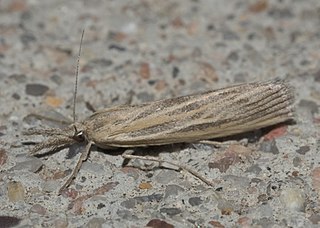| Parerupa | |
|---|---|
| Scientific classification | |
| Kingdom: | Animalia |
| Phylum: | Arthropoda |
| Class: | Insecta |
| Order: | Lepidoptera |
| Family: | Crambidae |
| Subfamily: | Crambinae |
| Tribe: | incertae sedis |
| Genus: | Parerupa Hampson, 1919 [1] |
| Synonyms | |
| |
| Parerupa | |
|---|---|
| Scientific classification | |
| Kingdom: | Animalia |
| Phylum: | Arthropoda |
| Class: | Insecta |
| Order: | Lepidoptera |
| Family: | Crambidae |
| Subfamily: | Crambinae |
| Tribe: | incertae sedis |
| Genus: | Parerupa Hampson, 1919 [1] |
| Synonyms | |
| |
Haimbachia is a genus of moths of the family Crambidae.
Neoschoenobia is a genus of moths of the family Crambidae.
Ptychopseustis is a genus of moths of the family Crambidae.

Ptochostola is a genus of moths of the family Crambidae.
Pseudocatharylla is a genus of moths of the family Crambidae.
Pseudobissetia is a genus of moths of the family Crambidae.
Paratraea is a genus of moths of the family Crambidae.
Perimeceta is a genus of moths of the family Crambidae.

Platytes is a genus of moths of the family Crambidae.
Prionapteryx is a genus of moths of the family Crambidae.
Prionotalis is a genus of moths of the family Crambidae.
Symphonia is a genus of moths of the family Crambidae.
Styphlolepis is a genus of moths of the family Crambidae.
Sebrus is a genus of moths of the family Crambidae.
Vaxi is a genus of moths of the family Crambidae.

Thaumatopsis is a genus of moths of the family Crambidae.
Tortriculladia is a genus of moths of the family Crambidae.
Parerupa bipunctalis is a moth in the family Crambidae. It was described by George Hampson in 1919. It is found in Nigeria.
Parerupa distictalis is a moth in the family Crambidae. It was described by George Hampson in 1919. It is found in Nigeria.
Parerupa undilinealis is a moth in the family Crambidae. It was described by George Hampson in 1919. It is found in Malawi.